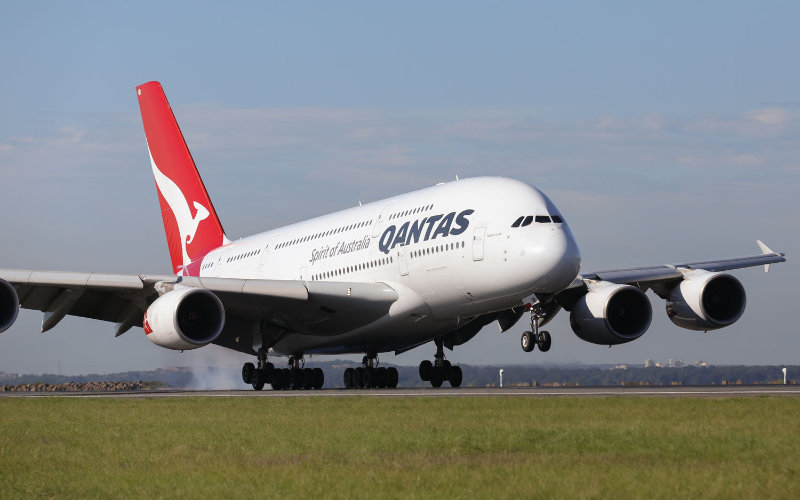Qantas international flights may become even more expensive as Airbus has issued a global directive concerning A380 wing cracks. Holus-bolus leasing of foreign aircraft and flight crew is now being considered. Michael Sainsbury with this exclusive investigation.
Qantas is being forced into urgent maintenance on two of its three double-decker A380 planes, due to fears at their manufacturer Airbus that some of the aircraft may have cracks in their wings due to problems with critical aircraft infrastructure. The superjumbos are the biggest planes in the sky and can carry up to 853 passengers.
The airline’s besieged chief executive Alan Joyce, who hitched a ride on the Prime Minister’s jet back from the Canberra Jobs and Skills Summit last week, now has another dilemma. The threat to Airbus revenues on his top international routes comes on top of soaring jet fuel prices, severe capacity issues and industrial unrest.
For long-suffering Qantas customers this raises the spectre of further chaos over the Christmas travel season. The airline is already struggling to deliver capacity on the most lucrative routes, desperately recruiting pilots, pulling training pilots out of retirement and engaged in an escalating industrial dispute with its dramatically constrained engineering division. It is even mulling leasing foreign aircraft and pilots to fill its capacity problems inflicted by management decisions.
Questions were put to Qantas public relations division for this story. As yet, no response has been forthcoming.
The unscheduled maintenance for the A380s – which is 50 days for each aircraft – and that will be conducted with a team from Airbus, threatens to exacerbate capacity constraints in Qantas international. Its post-Covid plans have already been stymied by the delayed delivery of new Boeing 787’s and the airline’s customers may find themselves flying on foreign owned and crewed 787s over Christmas, something insiders describe as “a new low” under Joyce’s management.
Such a move, they say, would further damage already cratering morale inside the airline.
Another spar for Qantas
The aircraft requiring maintenance are part of a global call-in of first generation A380 aircraft that is also expected to affect Singapore Airlines and Emirates. Each aircraft faces about 50 days out of service as engineers scour the critical “spar” infrastructure in the wing for cracks.
The spar is the main structural member of the wing, running span-wise at right angles (or thereabouts depending on wing sweep) to the fuselage. The spar carries flight loads and the weight of the wings while on the ground.
The aircraft were checked three years ago for cracks on the rear spar that were due to be rechecked this year but now the problems appear to have extended to the front spar as well.
On August 31, the European Union Aviation Safety Agency issued an Airworthiness Directive that requires operators to conduct checks and maintenance on the front and rear spars. It was posted by Australia’s Civil Aviation Safety Authority last week.
“Occurrences have been reported of finding cracks in the affected areas of the wing ORS on in-service A380 aeroplanes. This condition, if not detected and corrected, could reduce the structural integrity of the wing,” the European agency said.
“To address this potential unsafe condition, Airbus issued SB A380-57-8263 original issue to provide inspection instructions, and EASA issued AD 2019-0223, as an interim action, to require repetitive special detailed inspections (SDI), using ultrasonic testing methods, of the affected area of the wing ORS on a limited batch of aeroplanes. Since that AD was issued, it has been determined that additional areas may be affected by the same unsafe condition, and that all MSN must be inspected; consequently, Airbus issued the Airbus instructions, as defined in this AD, providing applicable instructions.”
 Loading...
Loading...
Engineers up in arms
Qantas engineers, already furious with the company for putting them on more onerous rosters 18 months ago and Joyce’s real wage cut pay offer, are being begged by management to work extra hours to check the A380s – at normal pay that has already fallen by as much as 10% behind the cost of living in three years, according to an offer made to engineers by management seen by MWM.
Understandably engineers who spoke to MWM are unimpressed. Last year, in a further cost-cutting drive, Qantas management unilaterally put Sydney engineers on eight-hour shifts, removing the 12-hour shifts that had increased productivity and allowed them to have five days off in a row. The return to eight-hour shifts has seen a significant increase in sick leave in the division.
“Pre-Covid in Sydney we worked a four-on, five-off 12-hour shift pattern, two days, two nights. Our managers then made us vote on a 10.9 hour four-on, four-off roster, or if we voted it down we would be put on an eight-hour roster,” one engineer explained.
This roster has significant negative impacts on mental health, family life and general wellbeing … Now they have definitely been caught with their pants down with capacity
Sydney is the only maintenance facility in Qantas to be put on this roster and engineers see it as a tactic to “break them”.
Joyce is spoiling for a fight with unions (pity about Qantas customers)
A Boeing pickle too
Qantas already has capacity problems on its international routes. For the “flying roo” this meant its A380s as well as three brand-new Boeing 787 Dreamliners that were not delivered due to Covid and now that delivery has been further delayed.
The aircraft are still owned by Boeing and registered in the US and so they need some modification prior to delivery. Boeing has a huge backlog due to the many shortcomings of Boeing’s own certification processes, people familiar with the process said. Still, there are some signs of movement with one 787 in Qantas livery reported to have been sent to Victorville in California where work should start on it soon.
A number of the Qantas A380s remain in what engineers refer to as “cold storage”. Bringing planes back into service requires about a month of heavy maintenance and cabin reconfiguration. Due to Joyce’s program of offshoring much of the company’s heavy maintenance, the work on the A380s must be largely carried out in Los Angeles. But Qantas has to battle with a slew of US airlines for the best staff.
The remainder is carried out in Abu Dhabi where Qantas competes for engineering time with Etihad which is itself also busy bringing its fleet up to capacity.
Qantas engineering sources said that in Los Angeles day-to-day maintenance is performed by poorly trained and poorly paid workers. As one told MWM:
It is a revolving door of staff there, as they have no safety net with employment conditions, the staff have no loyalty and will change employers to whoever pays better. We constantly see poor quality work from LA
Winged again: latest chapter of Alan Joyce’s ruinous reign at Qantas laid bare
To fill the massive capacity hole that the maintenance and delayed delivery of the 787s as well as any holes that the unexpected A380 maintenance might create, Qantas management is mulling so-called “wet” leases. These entail the leasing of aircraft along with flight and cabin crew, a variation on what is known as a “damp” lease with aircraft and flight crew only.
Qantas Domestic and International CEO Andrew David recently raised this prospect in “town hall” meetings with company staff, insiders said. And the Qantas pilots’ union is not happy.
“It has become clear that the wet leasing of capacity is under consideration by Qantas,” Australian International Pilots Associations president Tony Lucas said in a newsletter to his members last week. “We have heard reports of Qantas Executives mentioning wet leasing at town halls and other staff within Qantas discussing the option with various pilots and those members then sharing those discussions with AIPA.
“If Qantas chose this path it would be yet another example of a mismanaged airline that lacks sufficient aircraft capacity and appropriately trained crew. Passengers have ample choice of other airlines to fly with but when they book a Qantas flight they have an expectation that they will fly on a Qantas aircraft operated by Qantas pilots, with Qantas flight attendants and maintained by Qantas engineers.
“Since 2020 our members have endured and persevered with loyalty to the Company and this would be yet another blow to all of us to see Qantas take up this option.”
Michael Sainsbury is a former China correspondent who has lived and worked across North, Southeast and South Asia for 11 years. Now based in regional Australia, he has more than 25 years’ experience writing about business, politics and human rights in Australia and the Indo-Pacific. He has worked for News Corp, Fairfax, Nikkei and a range of independent media outlets and has won multiple awards in Australia and Asia for his reporting. He is a fierce believer in the importance of independent media.

